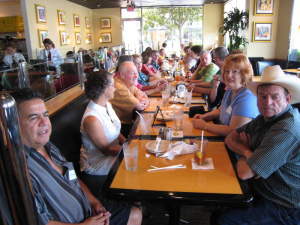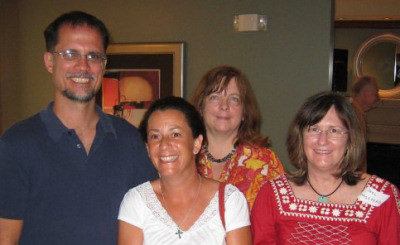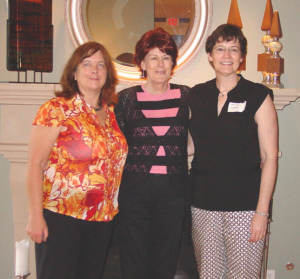We gathered from far and wide to enjoy the first Houston meeting on July 26th!
by Barbara Doré
 We were due to meet up for a pre-meeting lunch at the California Pizza Kitchen, only to find that the keener members of the group lost no time in high tailing it all the way from San Antonio or further well before lunch! Tom Gill enterprisingly drove all the way from Louisiana armed with only the restaurant name given him by Dr. Trent, and luckily found us – I think the Texas Lone Star was doing a sterling guiding job that day.
We were due to meet up for a pre-meeting lunch at the California Pizza Kitchen, only to find that the keener members of the group lost no time in high tailing it all the way from San Antonio or further well before lunch! Tom Gill enterprisingly drove all the way from Louisiana armed with only the restaurant name given him by Dr. Trent, and luckily found us – I think the Texas Lone Star was doing a sterling guiding job that day.
We took over around a sixth of the restaurant, much to the bemusement of the staff (who had initially said they ‘didn’t accept reservations’ and then wrote one on a napkin) only to find on the day that we really meant it and had to hastily clear us some space. Among us was a whole family reunion from Baby to Grandma as visitors from San Antonio met up with their folks from Houston.
 We had a great time – but then realized we were in danger of missing our Special Guest so raced back to base to meet up with Dr Trent. To our delight he brought his wife, who was really interesting to meet too. When we had all reconvened at the meeting, Dr. Jon Trent, medical oncologist and sarcoma specialist at MD Anderson Cancer Center, answered our questions for about an hour.
We had a great time – but then realized we were in danger of missing our Special Guest so raced back to base to meet up with Dr Trent. To our delight he brought his wife, who was really interesting to meet too. When we had all reconvened at the meeting, Dr. Jon Trent, medical oncologist and sarcoma specialist at MD Anderson Cancer Center, answered our questions for about an hour.
Photo: Dr. and Mrs. Trent, Barbara, and Carol
Plasma levels of imatinib
When we asked Dr. Trent about blood plasma level testing of Gleevec, he said that at the moment he is gathering information but that there are currently many unknowns — such as what the correct plasma level should be. It is unknown whether the plasma level remains constant, or whether some people adapt and their bodies clear it more efficiently with the passage of time. It is also unknown if the level of 1100 ng/ml is the optimal level. He said he would not increase the dose of Gleevec in someone who had a lower plasma level than 1100 ng/ml if the patient’s disease seemed stable. However, if there is disease progression, a low Gleevec plasma level would indicate that it is worth increasing the dose.
In addition, even just in exon 11 of the KIT gene alone there have been found 400 mutations, each of which may have a unique configuration and sensitivity to Gleevec (thus requiring a different Gleevec plasma level to control). Dr Trent said eventually it may be that treatment and dosing is tailored to the patient’s exact mutation.
Improved imatinib formulation
Dr. Trent was asked about the new and improved form of Gleevec that has been worked on (the wrapping version of the drug — known as WBZ-7 – which was created, produced and tested by three research teams, one headed by Ariel Fernandez from Rice University and the other two headed respectively by William Bornmann and Dr. Gabriel Lopez-Berestein from the University of Texas M. D. Anderson Cancer Center in Houston). Dr. Trent said it is thought that this version of the drug will be more effective as it conforms more closely to KIT, so it should bind to more mutations. However, further development is hindered as currently it has to be delivered intravenously (as it is insoluble), and the pharmaceutical companies are not currently convinced it is a viable project. However, if it were formulated in liposomes it would only need to be delivered once a month. Making it suitable to be taken as a tablet is the next goal.
Adjuvant therapy (post-surgery imatinib to prevent recurrence)
Dr. Trent talked about adjuvant therapy, explained the difference between the US study (measuring progression-free survival) and the European study (measuring overall survival). He also reviewed the 3-year study (Italy), and says he suspects that adjuvant therapy is for life.
More topics
Dr. Trent also said that he finds it professionally unethical to enter a patient on a double blind trial if he knows the patient might draw the placebo arm of the trial but has active disease and needs the treatment.
Dr. Trent said he is very impressed by what a friendly, supportive and knowledgeable group GSI is, and that he is inspired by seeing how we get together and help each other.
Support for Research
We asked about Dr. Trent’s research funding and he said that he is dependent on individual donations to keep his work going. The easiest way to support Dr. Trent’s research is to send any donations to his office so that he can make sure it is directed towards GIST research. The address is on the website on the donations page for anyone who wants it.
New Friends
 We had travellers from Midland, San Antonio, Austin, Missouri, Louisiana, plus Marina from Oklahoma! Eventually we had to call it a day to let everyone start out on their long journeys home. But it was great to meet the people we read about out the list, and will no doubt be bumping into each other at MDA from time to time until we organize another Houston meeting. It was fun, and we had a blast!
We had travellers from Midland, San Antonio, Austin, Missouri, Louisiana, plus Marina from Oklahoma! Eventually we had to call it a day to let everyone start out on their long journeys home. But it was great to meet the people we read about out the list, and will no doubt be bumping into each other at MDA from time to time until we organize another Houston meeting. It was fun, and we had a blast!
Photo: Barbara Doré (the meeting organizer), Kath Kimball, and Marina Symcox
For more photos from this meeting, plus many more, see our Photo Gallery.
Many thanks to Barbara Doré for making this get-together happen!

